Next time your forced-air gas furnace acts up, perhaps one of these basic troubleshooting tips will save you a service call. Plus we’ll show you some maintenance tips that will help keep your furnace in top shape. Compared to a gas furnace, an electric furnace is a bit simpler to understand. It has less parts and doesn’t require a chimney.
Mobile Home Gas Heater Maintenance and Troubleshooting
Please remember that this information is just a guide and in no way do we claim fault or liability if it doesn’t work for you. Use this article to help maintain and troubleshoot your furnace, but we recommend calling a qualified technician to perform any repair. If you attempt any repairs to your furnace, you are attempting them at your own risk. AGAIN, If any doubts please call a qualified technician to perform the repairs. Having said all that — let’s move on!
• Understand how your furnace works.
• Let the furnace tell you what’s wrong.
• Furnace runs constant short heating cycles.
• Burner won’t light — standing pilot furnace.
• Burner won’t light — electronic ignition furnace.
• Centrifugal switch or combustion air blower problem.
• Maintaining the blower assembly.
• Blower will not come on.
• Blower will not shut off.
• Inspecting the heat exchanger for deadly holes.
• Cleaning the A-coil.
• Replacing a furnace filter.
Understand How Your Heater Works
When problems arise, knowing how your gas furnace functions will help you determine what the problem may be. To understand how a typical manufactured home furnace operates, check out this flow-chart.
Let Your Mobile Home Furnace Tell You What’s Wrong
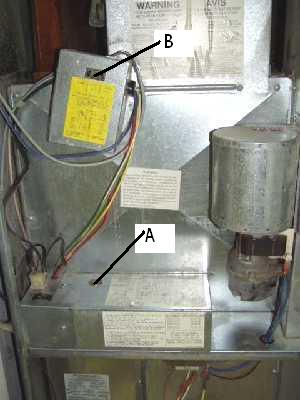 Many of the newer furnaces will practically tell you what’s wrong by locating a diagnostic code which is simply a flashing light. Often times the flashing code can be located by removing the top panel of the furnace. Item A in the photograph shows the location of the flashing code on this furnace. It uses a green light. If the light is solid it’s not detecting a problem. If the green light flashes, then there’s a problem. Count how many times the light is flashing in sequence and look up the diagnostic code in the furnace’s manual. Or you may find the diagnostic code posted on the furnace door or on the furnace itself. For instance, on some furnaces if your code flashes 3 times that means you have a bad centrifugal switch. The diagnostic code is different with all furnaces, so be sure your looking at the chart for yours. If you have an older furnace with a pilot light, most likely it won’t have any type of flashing diagnostic code system.
Many of the newer furnaces will practically tell you what’s wrong by locating a diagnostic code which is simply a flashing light. Often times the flashing code can be located by removing the top panel of the furnace. Item A in the photograph shows the location of the flashing code on this furnace. It uses a green light. If the light is solid it’s not detecting a problem. If the green light flashes, then there’s a problem. Count how many times the light is flashing in sequence and look up the diagnostic code in the furnace’s manual. Or you may find the diagnostic code posted on the furnace door or on the furnace itself. For instance, on some furnaces if your code flashes 3 times that means you have a bad centrifugal switch. The diagnostic code is different with all furnaces, so be sure your looking at the chart for yours. If you have an older furnace with a pilot light, most likely it won’t have any type of flashing diagnostic code system.
Item B has both a green and red light but this is not a diagnostic code for the furnace. This box is labeled blend-air and it’s function is to bring in fresh air. If there’s a problem with the blend-air unit, a red light will flash and you may hear a beep. Generally, if you do hear this unit beeping or see the red light flashing, it’s not a life-threatening warning and you will be OK to run your furnace until you can get it repaired. The unit should have a switch to shut off the beeper so it doesn’t drive you nuts.
If your furnace is still under warranty, you’ll want to get the blend-air (also called Fresh Air Fan) unit fixed as soon as possible or your warranty could be voided.
Furnace Runs Constant Short Heating Cycles
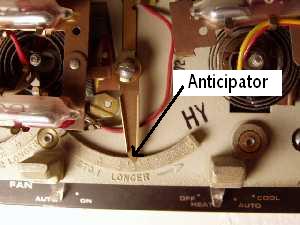 If your furnace runs fine but constantly runs many short heating cycles instead of an occasionally long (normal) one, then you need to make an adjustment inside the thermostat on the wall.
If your furnace runs fine but constantly runs many short heating cycles instead of an occasionally long (normal) one, then you need to make an adjustment inside the thermostat on the wall.
To make the adjustment, lift off the cover from the thermostat and locate the anticipator. If your furnace is running short cycles, the anticipator is probably set on .2 or lower. Check your furnace manual and move the lever or dial to the setting they recommend which is normally in the .3 to .4 range. Your short cycles should now cease. Some thermostats (like the one pictured) have an anticipator for both a/c and heat.
For optimum performance and safety of your furnace, you should never guess at the anticipator settings. Always refer to the manual or contact the manufacturer. You may also be able to get the anticipator settings by looking at the gas valve for the amp setting.
Burner Won’t Light
First determine if you have a standing pilot furnace or a furnace with an electronic ignition.
Standing Pilot Furnace. If your furnace has a pilot light that’s lit all the time, then you have a standing pilot furnace. Most older furnaces are standing pilot. On a side note, leaving your pilot lit all year long is a good idea as it helps keep out condensation preventing rust.
If the burner in your standing-pilot furnace won’t light, try these troubleshooting steps.
1) Thermostat. Make sure your thermostat is set to ‘heat’ and turned up.
2) Pilot Light. Be sure your pilot light is lit. To light, follow these steps:
a. Be sure gas to furnace is on.
b. Turn knob on gas valve to pilot.
c. Press knob down and hold (or slide and hold on some furnaces). Insert a long match inside furnace and light pilot.
d. Once the pilot is lit, continue holding down the button for at least 30 seconds.
e. Slowly let the button up. If the pilot remains lit, turn the knob to ‘on’ If pilot goes out, wait 5 minutes and repeat steps c thru e.
If the pilot does not light right away, you may have air in the line. Trying several times to light the pilot should eventually purge the air and allow the pilot to light. NOTE: Always wait 5 minutes before trying to relight a pilot to allow all residual gas to dissipate. If the pilot still doesn’t light, read on.
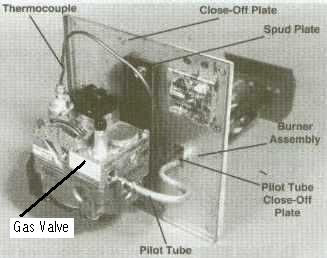 3) Thermocoupler. If the thermostat is set right and your pilot still won’t light, you could have a problem with the thermocoupler or a dirty pilot light (or both). First be sure that the thermocoupler hasn’t slipped or shifted and not getting the full flame from the pilot light. If that’s not the problem, then replace the thermocoupler and check that the pilot light is clear of any debri.
3) Thermocoupler. If the thermostat is set right and your pilot still won’t light, you could have a problem with the thermocoupler or a dirty pilot light (or both). First be sure that the thermocoupler hasn’t slipped or shifted and not getting the full flame from the pilot light. If that’s not the problem, then replace the thermocoupler and check that the pilot light is clear of any debri.
When you get the pilot lit, here’s one way to test that you have a strong thermocoupler:
a. With the gas valve on and a watch in hand, blow out the pilot light.
] b. Listen to the gas valve and count the seconds until you hear a click telling you that the gas valve has closed.
c. If you hear a click in 25 seconds or less, replace the thermocoupler and clean the pilot light. d. If you hear a click in 25-60 seconds, your thermocoupler is probably fine.
Wait 5 minutes before relighting pilot.
You’re probably wondering why it takes longer for a gas valve to close with a good thermocoupler and a clean pilot light? That’s because if everything is working properly, the thermocoupler will be hot which takes longer to cool down and signal the gas valve to close.
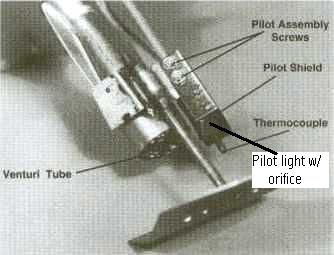 A thermocoupler only costs a few dollars and is available anywhere including stores like Walmart. Thermocouplers come in various lengths and length is not important in how it functions as long as it reaches from the gas valve to the pilot light.
A thermocoupler only costs a few dollars and is available anywhere including stores like Walmart. Thermocouplers come in various lengths and length is not important in how it functions as long as it reaches from the gas valve to the pilot light.
Since thermocouplers are so inexpensive, replacing it and cleaning the pilot light should always go hand in hand. Never do one without doing the other.
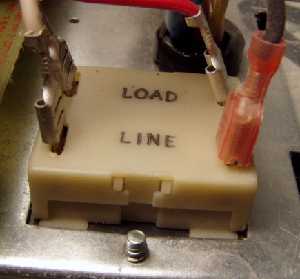 4) Transformer.A transformer converts the 110 volt power coming into your furnace to 24 volts for use by certain parts including the thermostat. When you locate the transformer, the connections that say ‘line’ are for the incoming 110 volts. The connections that says ‘load’ are the outgoing 24 volts. In fact, looking for the words ‘line’ and ‘load’ is one way to help locate the transformer inside your furnace. Of course not all transformers say ‘line’ and ‘load’ so learn what yours looks like before testing.
4) Transformer.A transformer converts the 110 volt power coming into your furnace to 24 volts for use by certain parts including the thermostat. When you locate the transformer, the connections that say ‘line’ are for the incoming 110 volts. The connections that says ‘load’ are the outgoing 24 volts. In fact, looking for the words ‘line’ and ‘load’ is one way to help locate the transformer inside your furnace. Of course not all transformers say ‘line’ and ‘load’ so learn what yours looks like before testing.
Using a voltage meter, first check that the transformer is receiving 110-120 volts on the ‘line’ side. Then test the ‘load’ side for 24-28 volts. Replace the transformer if the ‘load’ side is not registering 24-28 volts.
5) Gas Valve. If your burners still don’t light, then you probably need a new gas valve. Gas valves are expensive so be sure you’ve exhausted all the above sources before replacing.
Mobile Home Electronic Ignition Furnace
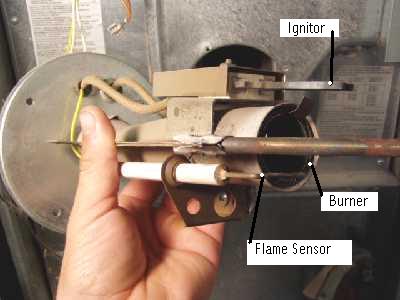 If your furnace doesn’t have a standing pilot light, then it has an electronic ignition. Furnaces have two types of electronic ignition — glow plugs or an electronic spark. In some cases this type of ignition may create a spark to light a pilot and then behave like a standing pilot furnace as talked about above. But for the most part, they behave as discussed in this section.
If your furnace doesn’t have a standing pilot light, then it has an electronic ignition. Furnaces have two types of electronic ignition — glow plugs or an electronic spark. In some cases this type of ignition may create a spark to light a pilot and then behave like a standing pilot furnace as talked about above. But for the most part, they behave as discussed in this section.
If the burners won’t light, try these troubleshooting steps:
A) Check for a flashing diagnostic code as talked about above.
B) Does the ignitor come on and glow for more than 5 seconds? If not, replace the ignitor.
C) If the ignitor comes on and the burners still don’t light, then replace the flame sensor and check that the orifice to the burner is clear.
D) If the burners still don’t light, then you may have a problem with the centrifugal switch, ignition control or gas valve. Neither fix is cheap and at this point you may want a qualified technician to examine your furnace.
Centrifugal Switch or Combustion Air Blower Problem.
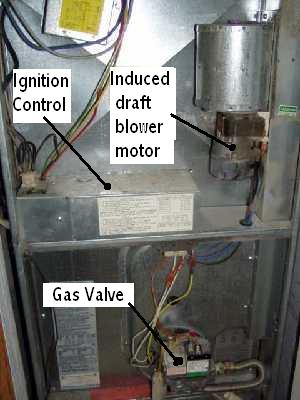 The combustion air blower, also known as an induced draft motor, has three functions. First, it purges or clears any residual gasses and/or by products out of the combustion chamber. Second, it continues to blow through to the flue to assist in the natural draft of the burned gas by-products. Third, it provides combustional air to the burners.
The combustion air blower, also known as an induced draft motor, has three functions. First, it purges or clears any residual gasses and/or by products out of the combustion chamber. Second, it continues to blow through to the flue to assist in the natural draft of the burned gas by-products. Third, it provides combustional air to the burners.
The centrifugal switch senses whether or not the combustion/induced draft blower is running. If running, the switch closes allowing current through the switch to start ignition. On some newer furnaces, a pressure switch may be used instead of a centrifugal switch.
Probably the only way you’ll know whether or not you have a problem with the centrifugal switch is because the ignition control (circuit panel) is flashing you a code telling you that the switch is either stuck open or stuck close. The code is telling you that either the switch is defective or there’s a problem with the combustion air blower. In many manufactured home furnaces, the centrifugal switch is located inside the combustion air blower. In that case, repairing the switch would also mean replacing the blower.
Another tell-tale sign of having a bad centrifugal or pressure switch is that you can hear the combustion/induced draft motor run and run without the burners ever lighting. Of course, when the burners don’t light after 2 or 3 tries, the furnace will shut down.
Maintaining The Blower Assembly.
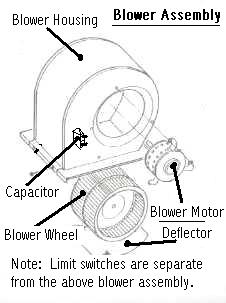 For the most part the blower assembly contains four parts — the blower wheel & it’s housing, the blower motor, the fan capacitor and the temperature control switches.
For the most part the blower assembly contains four parts — the blower wheel & it’s housing, the blower motor, the fan capacitor and the temperature control switches.
Capacitor. The fan capacitor is often connected to the side of blower housing (snail shell). Be sure to NOT touch the capacitor terminals. Even with the POWER OFF, the capacitor can/will store high voltage that can be injurious and/or fatal. The fan capacitor helps give the motor an extra burst of power to get it started. Whenever a blower motor is replaced, so should the fan capacitor.
The temperature control switches are generally separate from the blower assembly. More about those later.
Servicing the blower assembly basically means oiling the motor and cleaning the dirt out of the blower wheel and housing.
Belts. Some blowers are belt-driven meaning there’s a belt between the motor and blower, although this type of set-up is rare in a manufactured home furnace. If you have a belt-drive system, then maintenance should include inspecting the belt for wear and proper tension.
Oiling. If your blower motor needs oiling, that should be done twice a year. Manually-lubricated fan motors will have TWO oil ports. They will be on the non-shaft end of the motor. They will be straight across from each other at the edge of the end of motor. They will (if not previously removed) have a plastic plug in the holes (usually yellow or blue). A lot of times, if still legible, the fan label will say if it’s self-lubricated (meaning sealed with no oil ports).
To oil, place 1-4 drops of 3in1 SAE 20 motor oil (found in the blue and white can) into each oil port. If you have your manual/instructions for your furnace, read it and follow your units specifications on oiling and any other maintenance. Keep in mind that oiling too much is as bad as oiling too little.
Cleaning. The best way to clean the blower wheel (squirrel cage), blower housing and blower motor is to remove it by following these instructions:
Temperature switches determine when a blower runs and when it doesn’t. Names for these switches, which vary from furnace to furnace, are called fan control, limit switch, upper limit switch or lower limit switch. A furnace may have more than one of these switches.
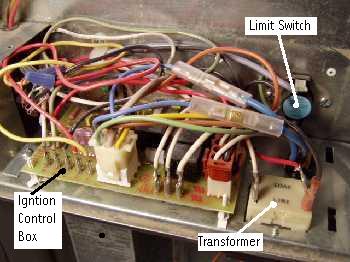 When the heat exchanger gets hot from the burners, either the fan control, limit switch or upper limit switch will tell the blower to turn on at a ‘pre-set’ temperature. When the burners are no longer lit because the call for heat by the thermostat has been met, then either the fan control, limit switch or lower limit switch will tell the blower to stop once the temperature inside the heat exchanger has cooled to a ‘pre-set’ temperature. Also remember that the burner ignites (comes ON) before the blower starts and extinguishes (goes OFF) before the blower shuts off.
When the heat exchanger gets hot from the burners, either the fan control, limit switch or upper limit switch will tell the blower to turn on at a ‘pre-set’ temperature. When the burners are no longer lit because the call for heat by the thermostat has been met, then either the fan control, limit switch or lower limit switch will tell the blower to stop once the temperature inside the heat exchanger has cooled to a ‘pre-set’ temperature. Also remember that the burner ignites (comes ON) before the blower starts and extinguishes (goes OFF) before the blower shuts off.
If your blower isn’t functioning properly, a possible cause is one of the above temperature switches. Do keep in mind that transformers, thermostats, fan relays, circuit boards and capacitors also affect how a blower functions and you could have a possible problem with one or several of these components. Calling a competent technician is always the most recommended way to troubleshoot your furnace problem.
Mobile Home Furnace Blower Will Not Come On.
If your blower does not turn on, first look through the viewing hole above the gas valve and see if the burners have lit. If you don’t see them burning, then jump to the burner won’t light section. If the burners DO light, they will then go out if the blower does not come on.
In determining why your blower doesn’t come on, first check to see that the problem isn’t in the blower motor itself. This is easily tested by moving the fan switch on your thermostat from ‘auto’ to ‘manual’ or ‘on’. This should start the blower right away. If the blower doesn’t start, then the problem could be a fuse inside the furnace, a loose connection or a bad blower motor.
If the blower does run when you move the fan switch to ‘manual’ or ‘on’, then the problem most likely is a faulty temperature switch.
Blower Will Not Shut Off.
If the blower does not shut off, shuts off too soon, or not soon enough because it blows cold air at the end of the heating cycle, then the problem is most likely a bad temperature control switch. If your furnace has a fan control, it may be adjustable. But for the most part the temperature control switches are non-adjustable and are to be replaced if found faulty.
If your blower does not shut off and it’s not blowing cold air, then that means the burner is still lit. You do not want the blower to stop if the burners are still lit.
To stop the furnace, first try turning down the thermostat. If that doesn’t work, then turn the furnace OFF at the thermostat. First the burner will shut off followed by the blower. If your furnace shuts off when you turn the thermostat to off, a possible cause is a malfunctioning thermostat and replacing it should fix your problem.
If turning the thermostat off doesn’t shut down the furnace, then locate the breaker in the fuse box or the main on/off switch on the furnace and switch to off. Then turn the gas off. You should find a gas shut-off right in front of the furnace. The problem of not shutting off could be anything from a short in the thermostat wires to a bad gas valve so its best to let a qualified technician troubleshoot and repair.
Inspecting the Heat Exchanger for Deadly Holes.
One of the main causes of carbon monoxide in your home is a bad heat exchanger in your furnace. With holes in your heat exchanger, instead of the carbon monoxide going up the chimney, it’s coming in your home. Carbon monoxide is an odorless gas. If exposed to it over time, it can get into your body causing sickness and even death. Once you’ve been diagnosed with carbon monoxide poisoning, it can literally take months to rid it from your body and you’ll feel sick the whole time. The best way to protect yourself from carbon monoxide is to install a carbon monoxide alarm.
There’s two ways of inspecting your heat exchanger for holes or cracks. One way is to remove the burner and do a visual inspection with a light and mirror. If you are a qualified technician, click here to view a PDF file from Coleman with details on doing a visual inspection and replacement. Remember, the pics in this PDF file are of a Coleman unit and those instructions are for THAT Coleman unit. Other Manufacturer’s units can/will be different from minor to major and the steps could vary greatly. Use caution, a wrong step could be hazardous.
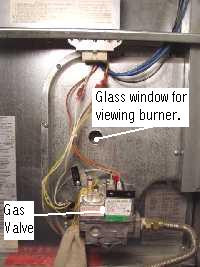 The second way to check for a possible bad heat exchanger is to simply watch the flame from your burner. First turn up the thermostat so the furnace engages. Looking through the glass viewing hole on your furnace, watch the burners light. Continue to watch the burners until the blower kicks on. If the flame of the burners start dancing when the blower kicks on, that’s a sign that you may have a bad heat exchanger as the blower is pushing air into it. Air from the blower should only flow over the heat exchanger — picking up the heat and cycling it into the home (hence the term heat exchanger).
The second way to check for a possible bad heat exchanger is to simply watch the flame from your burner. First turn up the thermostat so the furnace engages. Looking through the glass viewing hole on your furnace, watch the burners light. Continue to watch the burners until the blower kicks on. If the flame of the burners start dancing when the blower kicks on, that’s a sign that you may have a bad heat exchanger as the blower is pushing air into it. Air from the blower should only flow over the heat exchanger — picking up the heat and cycling it into the home (hence the term heat exchanger).
If you believe you have a problem with your heat exchanger, your furnace should be shut down (red tagged) and a service technician called immediately. Replacing a heat exchanger is not a minor repair. If your furnace is quite old, replacing the furnace may be a more viable option. Also note that doing any of these procedures without being certified and licensed with experience “can/probably will” void your unit warranty AND your home insurance policy should a fire/explosion or similar mishap occur and be proven to be the fault of said repair/procedure or be linked to furnace in any way.
Cleaning the A-coil
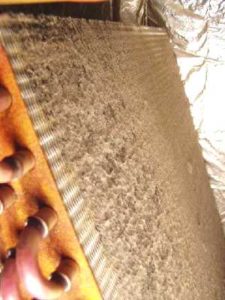 To ensure your furnace runs its best, your A-coil needs to be clean. If your home has a split-unit air conditioner, you will find an A-coil inside your furnace either above or below your blower. Even though you may not be running your air conditioner, air from the blower still needs to pass through the A-coil to heat your home. If your A-coil is dirty, your blower will have to work harder and you will be getting less air into your ductwork. For instructions on cleaning your a-coil, click here.
To ensure your furnace runs its best, your A-coil needs to be clean. If your home has a split-unit air conditioner, you will find an A-coil inside your furnace either above or below your blower. Even though you may not be running your air conditioner, air from the blower still needs to pass through the A-coil to heat your home. If your A-coil is dirty, your blower will have to work harder and you will be getting less air into your ductwork. For instructions on cleaning your a-coil, click here.
Replacing a Mobile Home Furnace Filter
Furnace filters should be changed every 30 days. Always use the type of filters recommended by the manufacturer. On most manufactured home furnaces, the filter(s) are located in the furnace door. The doors generally lift off and there’s often a top and bottom door. On some furnaces both doors require a filter and others only one door gets a filter.
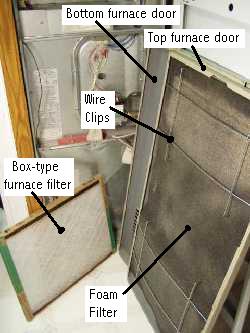 Foam filters have no front or back so can be installed either way. They are generally held in place with wire clips. When dirty foam filters can be hand-washed in warm soapy water. Be sure to rinse and let dry before re-installing. If you have a foam filter and have trouble locating a replacement, you can find one here.
Foam filters have no front or back so can be installed either way. They are generally held in place with wire clips. When dirty foam filters can be hand-washed in warm soapy water. Be sure to rinse and let dry before re-installing. If you have a foam filter and have trouble locating a replacement, you can find one here.
Box-type filters generally have an arrow somewhere along the edge that indicates the direction of air flow through the filter. Be sure this arrow is pointing towards the furnace. When box-type filters are dirty, throw them away and install new.
by Mark Bower and Robert Hardy
Need More Help?
If you have a more specific question or need further help, please post your question to our forum.
For Coleman parts, click here to visit our store.

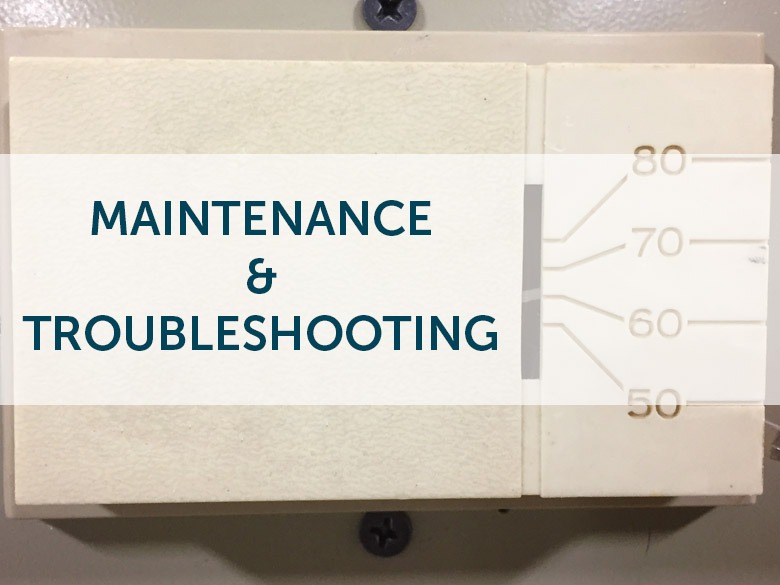
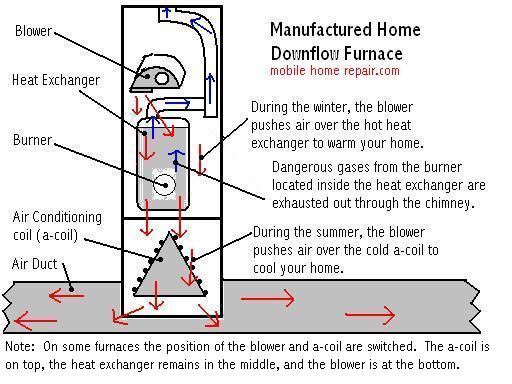
ok we have a miller furnace but it has an exults fan that runs of it to keep out posture in the space in the cieling but that motor burnt out i am looking for an replacement for that motor and can not find one ? I have a skyline 1997 double wide mobile home .
Please get in touch with our partner, The Aberdeen Mobile Home Parts Store (They are readily available by phone (605-229-2627) and email (AberdeenPartsStore at gmail.com)). They may be able to find the part for your or build one for you.
how do you get inside of the unit?
These furnaces are way over engineered or shall I say imagineered!! Why not keep things simple moving forward on the newer models only makes perfectly crystal clear sense right. We’re continuing to have issues with or model # M1MB70ABW, we’ve replaced the circuit board, switches, wall switch the list goes on and on, we live out in the country which you can imagine service calls are expensive and frustrating especially when the issue’s still arise and it gets to -30C or better where where located. The furnace does give us codes which we’ve relayed to the service technicians but still causing us stress. To make matters worse we also have a gas fireplace installed by the same modular manufacturer, we figured the gas fireplace would be our backup in case we’ve furnace quits but……….yes yet again I require tissues for my issues. Some with the furnace we’ve replaces components thermacouples, cleaned everything to as new condition placed the logs in their proper location & orientation but you guessed it still issues……… We’re almost thinking of going the old fashion way “WOOD BURNING” to avoid the hassle going nowhere except our wallets are much thinner. Please fire all your engineers and replace simple minded people the world would be a better place. If there’s anything you could do to help it would be much appreciated.
Lol great post I even went so far as installing a pellet stove cause the gas furnace was such a mess to deal with heats up to 2500 sq ft worked great!!! Till yea …electronics failed in the main board man I’ll tell ya a wood burning stove is and will always be the best solution !!! Had one for years back east in nfld and I’m going back to it again .!!! Engeniering by these companies now is just garbage products.quick sell and dollars every damn year to fix stuff.!! Hope all is well and you have resolved you’re issues !!!
my 1960 mobile home furnace makes a humming noise when not in use
what is that coming from the condenser? because when I turn the fan switch to off it stops making the humming noise
Hi Darryl,
We suggest you register in our mobile home repair forum and ask your question there! There you can provide more details and images so you can get some useful advice to make your decision.
Thanks!
Hi… We have a 1996 coleman evcon ac/heat unit. we have had the furnace art serviced and replaced most parts. now the air is acting up, Has anyone ever had the fan to kick on with out the unit on???? Or to just keep kicking on and off while in operation? It cools fine but the fan just will not run continues with the outside unit now. it kicks on and off the whole time it is running. Does the roof jack have anything to do with the A/C? or just the gas furnace?
The relay on my X995 856 mobile home furnace won’t light the furnace heater. I bought a new one and it still won’t light. any advise???